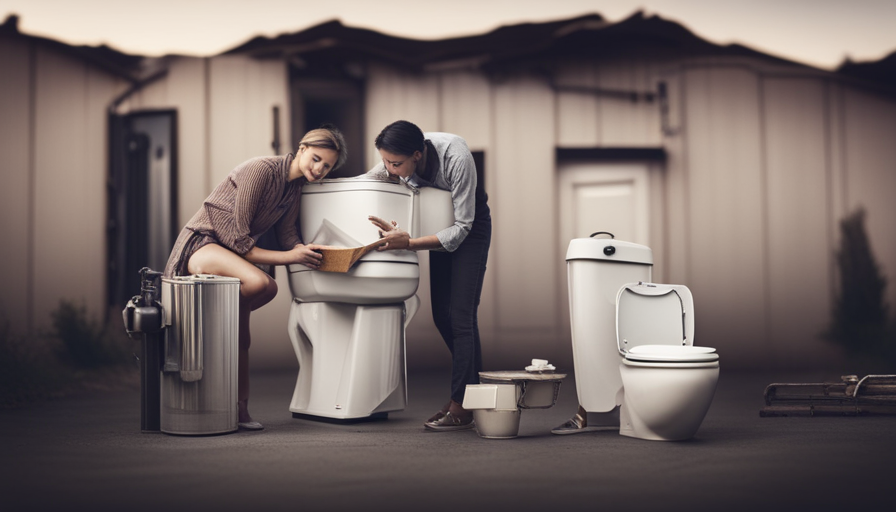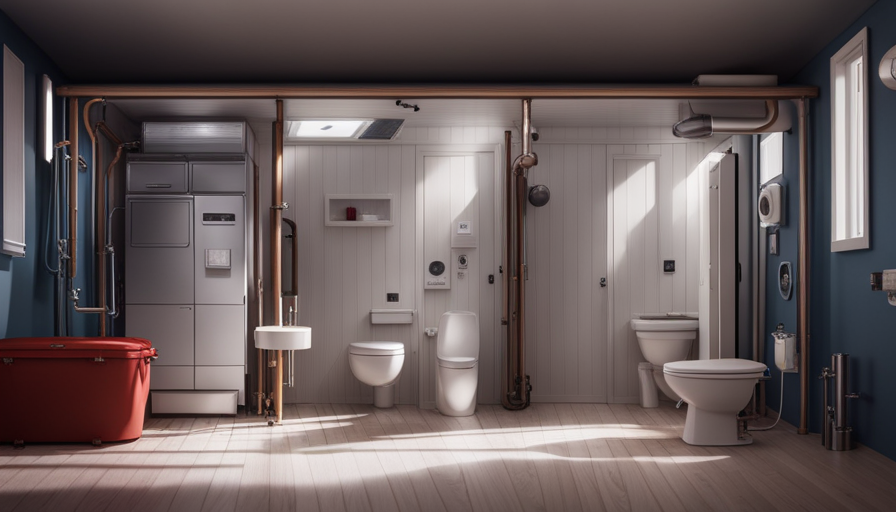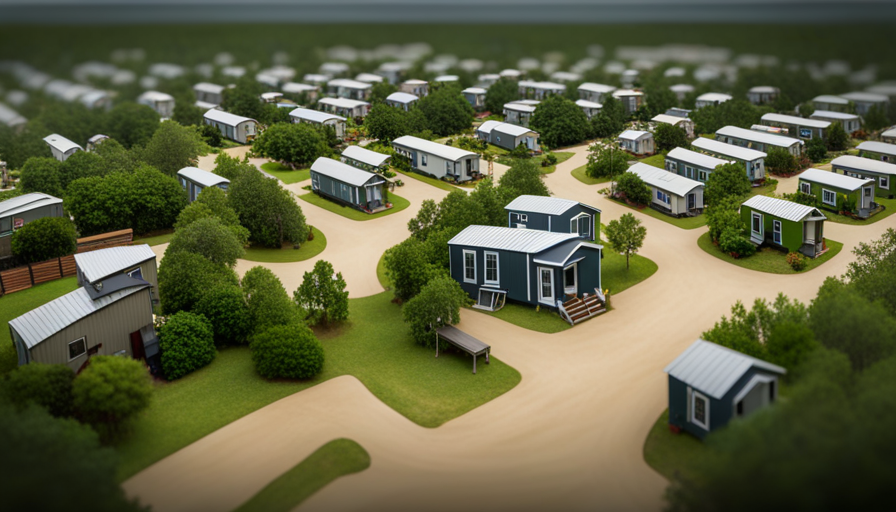Flush toilets are a crucial aspect of modern life, but in the setting of tiny homes, their function becomes a topic of intrigue and inquiry. So, what exactly is the process behind a flush toilet in a compact living area? Let me explore the intricacies of this important feature in a small dwelling.
Firstly, let’s understand the basics. A flush toilet operates by utilizing the force of water to remove waste from the bowl. This process involves a combination of gravity and pressure, allowing for efficient waste disposal.
In the realm of tiny houses, the design of flush toilets is tailored to fit the limited space available. Compact and space-saving, these toilets are ingeniously engineered to maximize functionality without compromising comfort.
Water efficiency and conservation are vital considerations when it comes to tiny house living. Flush toilets in tiny houses are designed to use minimal water while still ensuring effective waste removal, making them environmentally friendly and sustainable.
Proper waste management is of utmost importance in tiny houses. These toilets utilize a system that efficiently collects and disposes of waste, ensuring a hygienic and odor-free environment.
To ensure proper operation, plumbing and ventilation requirements must be met. These systems ensure the proper flow of water and prevent any potential health hazards associated with waste disposal.
For those living off-grid, innovative toilet solutions are available. Composting toilets and incinerating toilets provide effective waste management options without the need for traditional plumbing systems.
Mobile tiny houses present their unique challenges when it comes to flush toilets. Considerations such as weight distribution and securing the toilet while in transit must be taken into account.
Health and safety regulations dictate the requirements for toilet installations in tiny houses. Compliance with these guidelines is essential to ensure the well-being of occupants and the longevity of the toilet system.
Lastly, alternative toilet options exist for those seeking a different approach to waste management in tiny living spaces. Bidets, composting toilets, and dry toilets offer eco-friendly alternatives that can suit individual preferences and needs.
In conclusion, understanding how a flush toilet works in a tiny house involves exploring the basics of its operation, the compact design tailored for small spaces, water efficiency and conservation measures, waste management systems, plumbing and ventilation requirements, off-grid toilet solutions, considerations for mobile tiny houses, health and safety regulations, and alternative toilet options. Join me on this informative journey as we delve into the intricacies of flush toilets in tiny houses.
Key Takeaways
- Flush toilets in tiny houses utilize water force for waste removal through gravity and pressure.
- Compact and space-saving design maximizes functionality without compromising comfort.
- Minimal water usage makes flush toilets in tiny houses environmentally friendly.
- Proper plumbing and ventilation are necessary to prevent health hazards.
Understanding the Basics of a Flush Toilet
So, you’re probably wondering how exactly a flush toilet works in a tiny house, right? Well, let me break it down for you.
A flush toilet in a tiny house operates on the same basic principles as a regular flush toilet, but with a few key differences to accommodate the compact design and water efficiency.
Firstly, when you press the flush lever or button, it activates a mechanism that opens a valve at the bottom of the toilet tank. This allows water to rush into the bowl, creating a siphon effect. The siphoning action pulls down the waste and water from the bowl into the waste pipe, effectively flushing everything away.
In a tiny house, the compact design of the toilet is essential. The tank is usually smaller and more streamlined, taking up less space. Additionally, the pipes may be routed differently to fit within the limited confines of the tiny house.
Water efficiency is also a crucial consideration in a tiny house. To conserve water, many flush toilets in tiny houses use a dual-flush system. This means that you can choose between a full flush for solid waste and a half flush for liquid waste, reducing water usage.
Now that you understand the basics of how a flush toilet works in a tiny house, let’s explore the next section about compact design for tiny spaces.
Compact Design for Tiny Spaces
To maximize space in your compact abode, you’ll need a toilet that’s designed with tiny living in mind. When it comes to tiny house toilets, compact design is key. These toilets are specifically designed to fit into small spaces without sacrificing functionality.
One of the main features of a toilet designed for tiny spaces is compact storage. These toilets are often smaller in size, allowing them to fit into tight corners or even be mounted on the wall. This frees up valuable floor space in your tiny house, making it feel more open and spacious.
In addition to compact storage, these toilets also focus on space optimization. They are designed to be efficient in their use of space, with features like slim tanks and shorter bowls. Some models even have integrated sink systems, which eliminates the need for a separate sink and saves even more space.
To give you a better idea of the space-saving capabilities of a compact toilet, here is a table that compares the dimensions of a standard toilet to a compact toilet:
| Standard Toilet | Compact Toilet | |
|---|---|---|
| Length | 30-32 inches | 25-27 inches |
| Width | 20-22 inches | 18-20 inches |
| Height | 14-16 inches | 12-14 inches |
With a compact toilet, you can optimize your tiny space without compromising on comfort or functionality. And when it comes to water efficiency and conservation, these toilets have even more to offer. [Transition sentence into the next section about water efficiency and conservation.]
Water Efficiency and Conservation
Looking to save water and be more environmentally friendly? Opt for a compact toilet that not only maximizes your tiny space but also boasts impressive water efficiency and conservation features. These toilets incorporate various water-saving techniques to minimize water usage while still providing effective flushing power. Here are three key features to consider:
-
Dual Flush System: Many compact toilets offer a dual flush system, allowing you to choose between a full flush for solid waste and a reduced flush for liquid waste. This helps conserve water by only using the necessary amount for each type of waste.
-
Low Flow Technology: These toilets are designed with a low flow mechanism that restricts the amount of water used per flush. They typically use around 1.28 to 1.6 gallons of water, compared to the 3-5 gallons used by traditional toilets. This significant reduction in water usage contributes to water conservation efforts.
-
Greywater Recycling: Some compact toilets are equipped with greywater recycling systems. Greywater is the wastewater generated from sinks, showers, and laundry, which can be reused for purposes like flushing toilets. These systems filter and treat the greywater, making it safe for use in flushing, further reducing water consumption.
By incorporating these water-saving techniques and greywater recycling, compact toilets offer an eco-friendly solution for tiny houses.
Now, let’s move on to the next section and explore waste management in a tiny house.
Waste Management in a Tiny House
If you’re living in a compact space, managing waste efficiently becomes crucial for maintaining a clean and sustainable environment. In a tiny house, there are two main options for waste management: composting toilets and septic tank systems.
Composting toilets are an eco-friendly alternative to traditional flush toilets. These toilets use the natural process of decomposition to break down human waste into compost. The waste is collected in a separate compartment, where it’s mixed with sawdust or other organic materials to aid in the decomposition process. Composting toilets are odorless and require minimal water usage, making them ideal for tiny houses with limited resources.
On the other hand, septic tank systems are a more conventional option for waste management. These systems consist of a large underground tank that collects and treats the waste. The waste is broken down by bacteria and other microorganisms in the tank, and the treated water is then released into the ground. While septic tank systems require more space and maintenance compared to composting toilets, they can handle larger quantities of waste and are commonly used in areas without access to a centralized sewer system.
Transitioning into the next section about plumbing and ventilation requirements, it’s important to consider the specific needs and regulations associated with each waste management option.
Plumbing and Ventilation Requirements
When it comes to waste management in a tiny house, proper ventilation is crucial for odor control. Ventilation systems, such as exhaust fans or windows, help to remove unpleasant odors and maintain a fresh and clean environment.
Additionally, understanding the plumbing connections and pipe routing is essential for efficient waste disposal and water flow in a tiny house. This includes ensuring proper connections for the toilet, sink, and shower, as well as routing pipes to the appropriate outlets.
Proper Ventilation for Odor Control
To ensure your tiny house doesn’t become a stinky abode, it’s essential to have proper ventilation in place for effective odor control in your flush toilet. A well-designed ventilation system is crucial to remove foul odors and maintain a pleasant environment. There are various odor control methods that can be incorporated into your tiny house flush toilet system. These methods include using an exhaust fan, installing a vent pipe, and utilizing a vent stack.
To give you a better understanding, let’s take a look at the following table which outlines the benefits and considerations of these odor control methods:
| Odor Control Method | Benefits | Considerations |
|---|---|---|
| Exhaust Fan | – Removes odors effectively – Helps maintain fresh air inside – Can be automated |
– Requires electricity or battery power – Noise from the fan |
| Vent Pipe | – Allows odors to escape outside – Simple and cost-effective |
– Needs proper installation – Requires regular maintenance |
| Vent Stack | – Provides continuous ventilation – Prevents odors from entering living spaces |
– Requires vertical space – Needs proper sealing |
By incorporating these odor control methods into your tiny house flush toilet system, you can ensure a fresh and odor-free environment. Moving on to the next section about plumbing connections and pipe routing, we will explore how to properly connect your flush toilet to the plumbing system.
Plumbing Connections and Pipe Routing
Plumbing connections and pipe routing are like the circulatory system of your home, ensuring a smooth flow of waste and water. When it comes to plumbing installation in a tiny house, it’s crucial to consider the right materials for your pipes.
Most tiny houses use PVC pipes due to their affordability, durability, and ease of installation. These pipes are lightweight and resistant to corrosion, making them ideal for the limited space in a tiny house.
When routing the pipes, it’s important to plan the layout carefully to optimize space and ensure efficient water flow. Remember to consider the location of the flush toilet and connect it to the main sewer or septic system.
With proper plumbing connections and pipe routing, your tiny house will have a reliable and efficient toilet system.
Moving on to maintenance and cleaning tips, it’s important to keep your flush toilet clean and in good working condition for optimal performance.
Maintenance and Cleaning Tips
When it comes to maintaining and cleaning a tiny house, regular cleaning and sanitization are essential. This includes cleaning surfaces, floors, and fixtures to prevent the buildup of dirt, grime, and bacteria.
Additionally, troubleshooting common issues such as clogged drains or malfunctioning appliances is crucial to ensure the smooth operation of your tiny house.
Regular Cleaning and Sanitization
After you’ve given your tiny house toilet a thorough scrubbing, you’ll be amazed at how fresh and inviting it feels. Regular maintenance is key to keeping your toilet clean and sanitary.
To clean your toilet on a regular basis, start by using eco-friendly cleaning products that won’t harm the environment. Mix a solution of water and vinegar or baking soda to scrub the inside of the bowl, and use a toilet brush to remove any stubborn stains. Don’t forget to wipe down the seat, lid, and exterior of the toilet with a disinfectant wipe or spray.
Lastly, sanitize your toilet brush by soaking it in a mixture of bleach and water.
Now that your toilet is sparkling clean, let’s move on to troubleshooting common issues such as clogs or leaks.
Troubleshooting Common Issues
If you’re experiencing any issues with your compact bathroom, don’t worry – troubleshooting common problems is easier than you think! When it comes to a flush toilet in a tiny house, there are a few common issues that may arise, such as leaks and clogs. Here are some steps to troubleshoot these problems:
-
Troubleshooting leaks:
- Check the water supply connections for any loose fittings or leaks.
- Inspect the toilet tank and bowl for cracks or damaged seals.
- Ensure that the wax ring between the toilet and the floor is properly installed and not worn out.
-
Fixing clogs:
- Use a plunger to try and dislodge the blockage.
- If the plunger doesn’t work, try using a toilet auger to break up the clog.
- Consider using an enzyme-based drain cleaner to help dissolve the clog.
By following these troubleshooting steps, you can easily address common issues with your flush toilet. Next, we’ll discuss off-grid toilet solutions.
Off-Grid Toilet Solutions
Toilet solutions for off-grid tiny houses are diverse, and one interesting statistic is that composting toilets can save up to 6,000 gallons of water per year compared to traditional flush toilets. Off-grid composting toilets are a popular choice for tiny house owners who want to minimize their environmental impact and reduce their water usage.
These toilets work by separating solid waste from liquid waste. The solid waste is mixed with organic matter such as sawdust or coconut coir, which helps to facilitate the composting process. Over time, the waste breaks down into nutrient-rich compost that can be safely used as fertilizer.
Another option for off-grid toilets is chemical toilets. These toilets use chemicals to break down waste and neutralize odors. They typically have a separate compartment for waste and chemicals, and the waste can be emptied into an appropriate disposal site when full. Chemical toilets are convenient and easy to use, but they do require regular maintenance and the chemicals used can be harmful to the environment.
Considerations for mobile tiny houses include the size and weight of the toilet, as well as the availability of waste disposal facilities. Portable composting toilets are a popular choice for mobile tiny houses as they are lightweight and easy to move. Additionally, some portable toilets are designed to be self-contained, meaning they don’t require any external water or power source.
These considerations should be taken into account when choosing an off-grid toilet solution for a mobile tiny house.
Considerations for Mobile Tiny Houses
In my previous discussion about off-grid toilet solutions, I explored various options for tiny house owners who want to live sustainably and independently. Now, let’s delve into the considerations for mobile tiny houses, which present a unique set of challenges when it comes to toilet systems.
One crucial aspect to address in a mobile tiny house is the water supply. Since these houses are constantly on the move, a traditional flush toilet connected to a fixed plumbing system is not feasible. Instead, mobile tiny houses often rely on portable water tanks, which can be refilled as needed. These tanks provide the necessary water for flushing and maintaining proper hygiene.
Another popular option for mobile tiny houses is composting toilets. These innovative systems use natural processes to break down waste into compost, eliminating the need for water. Composting toilets are not only eco-friendly, but they also offer flexibility for mobile living. They require minimal maintenance, and the resulting compost can be safely disposed of or used as fertilizer.
Considering the challenges of a mobile lifestyle, finding the right toilet system for a tiny house is crucial. Now, let’s explore how health and safety regulations play a role in determining the best toilet solution for tiny house living.
Health and Safety Regulations
Health and safety regulations play a vital role in determining the best toilet solution for maintaining a safe and hygienic mobile tiny house. When it comes to health regulations, it’s important to consider the disposal of waste in a way that doesn’t pose a threat to human health or the environment. Safety guidelines also need to be followed to ensure that the toilet system is installed correctly and doesn’t present any risks to the occupants of the tiny house.
One important health regulation to consider is the proper treatment and disposal of waste. In most areas, it’s required to have a septic system or connection to a sewer line for waste disposal. This ensures that the waste is properly contained and treated to prevent contamination of the surrounding environment and water sources.
In terms of safety guidelines, it’s important to choose a toilet system that’s suitable for the limited space and weight restrictions of a mobile tiny house. Additionally, the installation of the toilet system should be done following the manufacturer’s instructions and any applicable building codes to ensure that it’s secure and doesn’t pose a risk of leaks or other hazards.
Considering health regulations and safety guidelines is crucial when choosing a toilet solution for a mobile tiny house. By following these regulations and guidelines, you can ensure a safe and hygienic environment for living. Now let’s explore alternative toilet options for tiny living.
Alternative Toilet Options for Tiny Living
In this discussion, I’ll explore two alternative toilet options for tiny living: dry toilet systems and portable camping toilet solutions.
Dry toilet systems are a popular choice among tiny house owners as they require no water or plumbing, making them highly sustainable and cost-effective.
Portable camping toilet solutions, on the other hand, offer convenience and flexibility, allowing tiny house dwellers to easily transport and dispose of waste while on the go.
Dry Toilet Systems
Toilet systems in tiny houses can be as simple as using a composting toilet. This allows you to go about your business without worrying about plumbing or water consumption, and it’s a real game-changer!
Dry composting toilets are a popular choice in tiny house living. They require no water and use a natural decomposition process to break down waste into compost. These toilets typically consist of a separate chamber for liquids and solids. The solids compartment contains organic material like peat moss or coconut coir to aid in the decomposition process.
Another option is incinerating toilets, which use high temperatures to burn waste into ash. This eliminates the need for any type of waste disposal, as the ash can be easily disposed of.
With these dry toilet systems, you can have a functional and eco-friendly bathroom in your tiny house.
Now, let’s explore portable camping toilet solutions.
Portable Camping Toilet Solutions
Bring the convenience of a portable camping toilet with you on your outdoor adventures, allowing you to easily take care of your bathroom needs wherever you go.
There are several options available for portable camping toilets, including portable composting toilets and chemical toilets.
-
Portable composting toilets: These toilets use a combination of peat moss, sawdust, or coconut coir to break down waste into compost. They’re environmentally friendly and don’t require water or chemicals.
-
Chemical toilets: These toilets use chemicals to break down waste and control odors. They typically have a holding tank for waste and a separate tank for flushing water mixed with chemicals.
-
Compact and lightweight: Portable camping toilets are designed to be easily transported and set up, making them ideal for camping trips or road trips.
-
Easy to clean and maintain: Most portable camping toilets have removable waste tanks, making them easy to empty and clean.
Whether you choose a portable composting toilet or a chemical toilet, these portable solutions offer convenience and functionality for your outdoor bathroom needs.
Frequently Asked Questions
What are the different types of flush toilets available for tiny houses?
There are several types of flush toilets available for tiny houses, each with its own pros and cons.
One interesting statistic is that composting toilets are becoming increasingly popular among tiny house owners, with over 70% of them opting for this eco-friendly option. Composting toilets use natural processes to break down waste into compost, eliminating the need for water and sewage connections. While they require regular maintenance, they’re odorless and can be a sustainable choice for tiny living.
Can a flush toilet be installed in a tiny house without access to a sewage system?
Toilet alternatives for tiny houses without access to a sewage system include composting toilets. These toilets use a natural process to break down waste into compost, reducing odor and environmental impact. They typically consist of a solid waste container, a liquid waste container, and a ventilation system to promote decomposition.
Composting toilets require regular maintenance, such as emptying the containers and adding composting materials. They offer a sustainable and efficient solution for waste management in tiny house living.
Are there any specific health and safety regulations that need to be followed when using a flush toilet in a tiny house?
When using a flush toilet in a tiny house, it’s crucial to follow specific health and safety regulations. Ensuring proper ventilation and adequate plumbing connections are essential to prevent any potential health risks.
Additionally, regular maintenance and cleaning of the toilet are necessary to maintain hygiene standards. It’s important to note that using a flush toilet can have health benefits, such as improved sanitation, but it also has an environmental impact due to the water usage.
What are some alternative toilet options for tiny living besides a flush toilet?
When it comes to alternative toilet options for tiny living, there are a few choices besides a flush toilet.
Composting toilets are a popular option, as they use natural processes to break down waste into compost. They’re eco-friendly and require minimal water usage.
Another option is incinerating toilets, which use high temperatures to burn waste into ash. These toilets are compact and odor-free, but they do require a power source.
Both options provide efficient and sustainable solutions for tiny house living.
How often does a flush toilet in a tiny house need to be maintained and cleaned?
The frequency of maintenance for a flush toilet in a tiny house depends on usage, but generally, it should be cleaned and maintained at least once a week.
To clean, start by removing any visible debris and scrubbing the bowl with a toilet brush and a mild cleaner. Don’t forget to clean the seat, lid, and handle as well.
Regularly check for leaks and ensure the tank is functioning properly.
Conclusion
In conclusion, understanding how a flush toilet works in a tiny house is crucial for efficient waste management and water conservation. By utilizing a compact design and considering the plumbing and ventilation requirements, one can ensure proper functionality in limited spaces.
Additionally, off-grid toilet solutions and alternative options such as composting toilets can be explored for mobile tiny houses. For instance, Sarah, a tiny house owner in California, installed a composting toilet and was able to reduce her water usage by 90% while effectively managing her waste.
By implementing these strategies, tiny house dwellers can enjoy the comforts of a flush toilet while minimizing their environmental impact.
Hi, I’m Emma. I’m the Editor in Chief of Tiny House 43, a blog all about tiny houses. While tree houses are often associated with childhood, they can be the perfect adult retreat. They offer a cozy space to relax and unwind, surrounded by nature. And since they’re typically built on stilts or raised platforms, they offer stunning views that traditional homes simply can’t match. If you’re looking for a unique and romantic getaway, a tree house tiny house might just be the perfect option.










